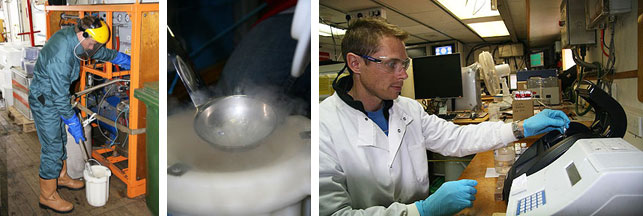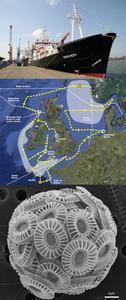We are currently carrying out a CTD station in view of the limestone promontory of Portland Bill, with Dorset’s ‘Jurassic Coast’ spread out in front of us.
Today’s blog entry, again by Dave Suggett, describes work done on the ship to examine phytoplankton pigments.
Another one of our interests on this cruise is to examine the phytoplankton pigment characteristics; again, as with the elemental composition work (yesterday’s blog), we must first collect the phytoplankton material on filters before analysis. Pigments are special molecules phytoplankton use to harvest sunlight. Most famously, the pigment chlorophyll-a is the reason most plants and algae (and parts of the planet!) are tinged green, but there are many others. Pigments not only tell us what types of phytoplankton exist in the water (different phytoplankton groups have evolved their own unique pigments) but also their physiological state.
In addition, they are what let us ‘see’ phytoplankton from space: as well as the pigments characteristic of their group, all phytoplankton species contain the pigment chlorophyll-a just mentioned; this pigment modifies the intensity and colour of the light leaving the ocean in an upwards direction, and therefore the amount of chlorophyll-a present in seawater can be calculated from specialised optical instruments placed onto satellites. This amount of chlorophyll-a can be used as general indicator of how much living phytoplankton is in the surface ocean.

We quantify the chlorophyll-a concentration on board by extracting the pigment into a solvent for 24 hours; the solvent bound extract is then analysed on a fluorometer (an instrument that is tuned to measure the fluorescence arising solely from chlorophyll-a, the intensity of which has been pre-calibrated against known chlorophyll-a concentrations). However, most of the other pigments we wish to examine cannot be quantified on board since this requires specialised and sensitive instrumentation, high performance liquid chromatographers and mass spectrometers; therefore, our samples are ‘flash’ frozen in liquid nitrogen as soon as possible to preserve their pigment compliment. This step is critical since phytoplankton are designed to live in the highly variable light environments of the oceans (through wind mixing, cloud cover, and light scatter from passing waves) and so continually modify their pigments, and over very short time scales (minutes), to optimise light harvesting capacity.

Phytoplankton achieve such optimisation by rapidly synthesising either ‘protective’ or ‘active’ pigments that are designed to respectively divert light from or channel light into the reaction centres (batteries) that generate the energy for photosynthesis. In other words, the purpose of most pigments is to gather sunlight, but the purpose of some is to dissipate sunlight. In particular under high light exposure, this is their self-generated means of coating themselves in sunscreen.
Our pigment information will ultimately enable us to follow changes of phytoplankton abundance, detect which species are present, and examine physiology across broad scale environmental changes, including those of pH and ocean acidification.

